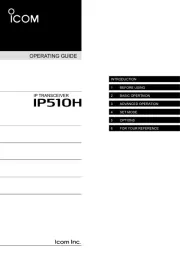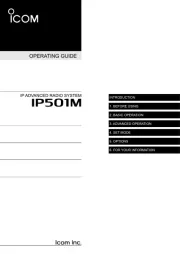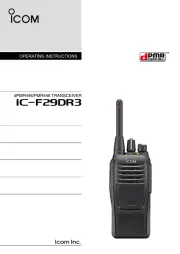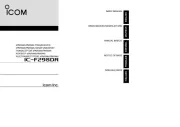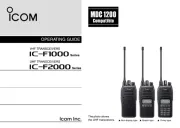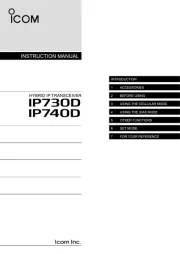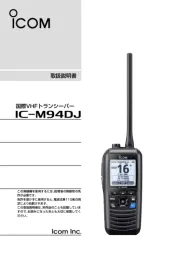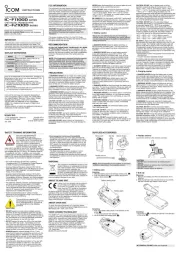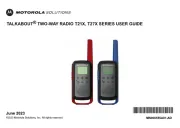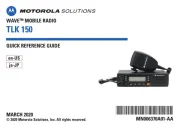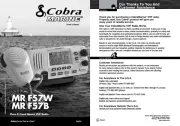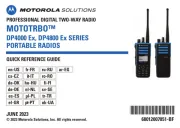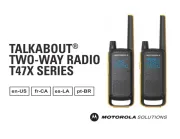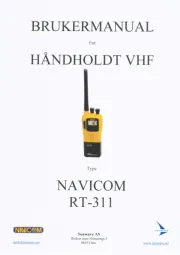
RDANGER! NEVER operate the transceiver near
unshielded electrical blasting caps or in an explosive
atmosphere. This could cause an explosion and death.
RWARNING! NEVER use or charge Icom battery packs
with non-Icom transceivers or non-Icom chargers. Only
Icom battery packs are tested and approved for use with
Icom transceivers or charged with Icom chargers. Using
third-party or counterfeit battery packs or chargers may
cause smoke, re, or cause the battery to burst.
RWARNING! NEVER hold the transceiver so that the
antenna is very close to, or touching exposed parts of the
body, especially the face or eyes, while transmitting.
RWARNING! NEVER operate the transceiver with a
headset or other audio accessories at high volume levels.
The continuous high volume operation may cause a
ringing in your ears. If you experience the ringing, reduce
the volume level or discontinue use.
RWARNING! NEVER operate the transceiver while
driving a vehicle. Safe driving requires your full attention—
anything less could result in an accident.
CAUTION: DO NOT short the terminals of the battery
pack. Shorting may occur if the terminals touch metal
objects such as a key, so be careful when placing the
battery packs (or the transceiver) in bags, and so on.
Carry them so that shorting cannot occur with metal
objects. Shorting may damage not only the battery pack,
but also the transceiver.
CAUTION: DO NOT use harsh solvents such as Benzine
or alcohol when cleaning. This could damage the
equipment surfaces. If the surface becomes dusty or dirty,
wipe it clean with a soft, dry cloth.
CAUTION: DO NOT place or leave the transceiver in
excessively dusty environments. This could damage the
NEVER place the transceiver in an insecure place to avoid
inadvertent use by unauthorized persons.
DO NOT place or leave the transceiver in areas with
temperatures below –30°C (–22°F) or above +60°C
(+140°F), or in areas subject to direct sunlight, such as the
BE CAREFUL! The transceiver meets IP67* requirements
for dust tight and waterproof protection. However,
once the transceiver has been dropped, dust tight and
waterproof protection cannot be guaranteed due to the
fact that the transceiver may be cracked, or the waterproof
* Only when the battery pack, antenna, and connector
cover or the optional speaker microphone is attached.
Icom is not responsible for the destruction, damage to, or
performance of any Icom or non-Icom equipment, if the
malfunction is because of:
• Force majeure, including, but not limited to, res,
earthquakes, storms, oods, lightning, other natural
disasters, disturbances, riots, war, or radioactive
•The use of Icom transceivers with any equipment that is
not manufactured or approved by Icom.
This equipment has been tested and found to comply with
the limits for a Class A digital device, pursuant to part 15
of the FCC Rules. These limits are designed to provide
reasonable protection against harmful interference when
the equipment is operated in a commercial environment.
This equipment generates, uses, and can radiate
radio frequency energy and, if not installed and used
in accordance with the instruction manual, may cause
harmful interference to radio communications. Operation
of this equipment in a residential area is likely to cause
harmful interference in which case the user will be
required to correct the interference at his own expense.
CAUTION: Changes or modications to this transceiver,
not expressly approved by Icom Inc., could void
your authority to operate this transceiver under FCC
This device complies with Part 15 of the FCC Rules.
Operation is subject to the condition that this device does
not cause harmful interference.
CLEAN THE TRANSCEIVER THOROUGHLY IN A BOWL
OF FRESH WATER after exposure to saltwater, and dry
it before operating. Otherwise, the transceiver’s keys and
switches may become unusable, due to salt crystallization,
and/or the charging terminals of the battery pack may
NOTE: If the transceiver’s waterproof protection appears
defective, carefully clean the transceiver with a soft,
damp (fresh water) cloth, then dry it before operating.
The transceiver may lose its waterproof protection if the
case, jack cap, or connector cover is cracked or broken,
or the transceiver has been dropped.
Contact your Icom distributor or your dealer for advice.
Icom and the Icom logo are registered trademarks of
Icom Incorporated (Japan) in Japan, the United States,
the United Kingdom, Germany, France, Spain, Russia,
Australia, New Zealand, and/or other countries.
AQUAQUAKE is a trademark of Icom Incorporated.
AMBE+2 is a trademark and property of Digital Voice
word mark and logos are registered
trademarks owned by Bluetooth SIG, Inc. and any use of
such marks by Icom Inc. is under license.
All other products or brands are registered trademarks or
trademarks of their respective holders.
RDANGER! Personal death, serious injury or an
RWARNING! Personal injury, re hazard or electric
CAUTION Equipment damage may occur.
NOTE Recommended for optimum use. No risk
of personal injury, re or electric shock.
Misuse of Li-ion batteries may result in the following
hazards: smoke, re, or the battery may rupture. Misuse
can also cause damage to the battery or degradation of
RDANGER! NEVER place battery packs near a re.
Fire or heat may cause them to rupture or explode.
Dispose of used battery packs in accordance with local
RDANGER! NEVER let uid from inside the battery get in
your eyes. This can cause blindness. Rinse your eyes with
clean water, without rubbing them, and immediately get
medical treatment from an eye doctor.
RWARNING! NEVER solder the battery terminals, or
NEVER modify the battery pack. This may cause heat
generation, and the battery may burst, emit smoke or
RWARNING! NEVER place or leave battery packs
in areas with temperatures above 60°C (140°F). High
temperature buildup in the battery cells, such as could
occur near res or stoves, inside a sun-heated vehicle,
or in direct sunlight for long periods of time may cause
the battery cells to rupture or catch re. Excessive
temperatures may also degrade the battery pack’s
performance or shorten the battery cell’s life.
NEVER strike or otherwise impact the
battery pack. Do not use the battery pack if it has been
severely impacted or dropped, or if the pack has been
subjected to heavy pressure. Battery pack damage may
not be visible on the outside of the case. Even if the
surface of the battery does not show cracks or any other
damage, the cells inside the battery may rupture or catch
RWARNING! NEVER use deteriorated battery packs.
RWARNING! NEVER put the battery pack in a microwave
oven, high-pressure container, or in an induction heating
cooker. This could cause a re, overheating, or cause the
battery cells to rupture.
RWARNING! NEVER Iet uid from inside the battery cells
come in contact with your body. If it does, immediately
CAUTION: DO NOT continue to use the battery pack if
it emits an abnormal odor, heats up, or is discolored or
deformed. If any of these conditions occur, contact your
Icom dealer or distributor.
CAUTION: DO NOT expose the battery pack to rain,
snow, saltwater, or any other liquids. Do not charge or use
a wet pack. If the pack gets wet, be sure to wipe it with a
clean dry cloth before using.
CAUTION: DO NOT use the battery pack out of the
specied temperature range for the transceiver –30°C
~ +60°C (–22°F ~ +140°F), and the battery itself –20°C
~ +60°C (–4°F ~ +140°F). Using the battery out of its
specied temperature range will reduce its performance
and battery cell’s life. Please note that the specied
temperature range of the battery may exceed that of the
transceiver. In such cases, the transceiver may not work
properly because it is out of its operating temperature
CAUTION: DO NOT leave the pack fully charged,
completely discharged, or in an excessive temperature
environment (above 60°C, 140°F) for an extended
period of time. If the battery pack must be left unused
for a long time, it must be detached from the transceiver
after discharging. You may use the battery pack until the
remaining capacity is about half, then keep it safely in a
cool and dry place at the following temperature range:
–20°C ~ +50°C (–4°F ~ +122°F) (within a month)
–20°C ~ +40°C (–4°F ~ +104°F) (within three months)
–20°C ~ +20°C (–4°F ~ +68°F) (within a year)
BE SURE to replace the battery pack with a new one
approximately ve years after manufacturing, even if it still
holds a charge. The material inside the battery cells will
become weak after a period of time, even with little use.
The estimated number of times you can charge the pack
is between 300 and 500. Even when the pack appears to
be fully charged, the operating time of the transceiver may
• Approximately 5 years have passed since the pack was
•The pack has been repeatedly charged.
The battery cells may deteriorate and swell due to their
characteristics if used in an environment and conditions
such as: frequently charged, recharged immediately after
full charge, used or saved in a hot place, or charged
by methods other than the instructions. If the battery
pack swells, it has reached the end of its life due to
deterioration. Replace it with a brand new one.
RWARNING! NEVER charge the transceiver during a
lightning storm. It may result in an electric shock, cause
a re or damage the transceiver. Always disconnect the
power adapter before a storm.
RWARNING! NEVER charge or leave the battery in the
battery charger beyond the specied time for charging. If
the battery is not completely charged by the specied time,
stop charging and remove the battery from the battery
charger. Continuing to charge the battery beyond the
specied time limit may cause a re, overheating, or the
RWARNING! Occasionally observe the battery pack
condition while charging. If any abnormal condition occurs,
discontinue using the battery pack.
CAUTION: DO NOT charge the battery pack in areas with
extremely high temperatures, such as near res or stoves,
inside a sun-heated vehicle, or in direct sunlight. In such
environments, the safety/protection circuit in the battery
will activate, causing the battery to stop charging.
CAUTION: DO NOT insert the transceiver (battery
attached to the transceiver) into the charger if it is wet or
soiled. This could corrode the battery charger terminals or
damage the charger. The charger is not waterproof.
CAUTION: DO NOT charge the battery pack outside of the
specied temperature range: 15˚C to 40˚C (59˚F to 104˚F).
Icom recommends charging the pack at 25˚C (77˚F). The
pack may heat up or rupture if charged out of the specied
temperature range. Additionally, pack’s performance or
battery cell life may be reduced.
CAUTION: DO NOT use the power adapter unless
the power outlet is easily accessible and near the unit.
Remove it from the AC power outlet when not in use.
SAFETY TRAINING INFORMATION
Your Icom radio generates RF
electromagnetic energy while
transmitting. This radio is designed for
and classied as for “Occupational Use
Only.” This means it must be used only
during the course of employment by
individuals aware of the hazards, and the
ways to minimize such hazards. This
radio is NOT intended for use by the “General Population”
in an uncontrolled environment. This radio has been tested
and complies with the FCC and IC RF exposure limits for
“Occupational Use Only”. In addition, your Icom radio
complies with the following Standards and Guidelines with
regard to RF energy and electromagnetic energy levels
and evaluation of such levels for exposure to humans:
• FCC KDB Publication 447498 D03, Evaluating
Compliance with FCC Guidelines for Human Exposure
to Radio Frequency Electromagnetic Fields.
• American National Standards Institute (C95.1-2010),
IEEE Standard for Safety Levels with Respect to Human
Exposure to Radio Frequency Electromagnetic Fields,
• American National Standards Institute (C95.3-2002),
IEEE Recommended Practice for the Measurement of
Potentially Hazardous Electromagnetic Fields– RF and
• The antennas, batteries, belt clips, speaker-microphone,
and other accessories that are listed in “OPTIONS”
on this sheet, are authorized for use with this product.
Use of accessories other than those specied may
result in RF exposure levels exceeding the FCC and IC
requirements for wireless RF exposure.
•Health Canada Safety Code 6 - Limits of Human
Exposure to Electromagnetic Energy in the Frequency
Range from 3 kHz to 300 GHz.
To ensure that your expose to RF
electromagnetic energy is within the FCC
and IC allowable limits for occupational
use, always adhere to the following
• operate the radio without a proper antenna DO NOT
attached, as this may damage the radio and may also
cause you to exceed FCC and IC RF exposure limits. A
proper antenna is the antenna supplied with this radio by
the manufacturer or an antenna specically authorized
by the manufacturer for use with this radio.
• transmit for more than 50% of the total radio DO NOT
use time (“50% duty cycle”). Transmitting more than
50% of the time can cause FCC and IC RF exposure
compliance requirements to be exceeded. The radio is
transmitting when the status indicator lights red. You can
cause the radio to transmit by pushing the [PTT] switch.
• ALWAYS keep the antenna at least 2.5 cm (1 inch)
away from the body when transmitting, and only use the
Icom belt-clips listed in “OPTIONS” on this sheet when
attaching the radio to your belt, or other place, to ensure
FCC and IC RF exposure compliance requirements are
The information listed above provides the user with
the information needed to make him or her aware of
RF exposure, and what to do to assure that this radio
operates within the FCC and IC RF exposure limits of
•Electromagnetic Interference/Compatibility
During transmissions, your Icom radio generates RF
energy that can possibly cause interference with other
devices or systems. To avoid such interference, turn o
the radio in areas where signs are posted to do so. DO
NOT operate the transmitter in areas that are sensitive
to electromagnetic radiation such as hospitals, aircraft,
•Occupational/Controlled Use
The radio transmitter is used in situations in which
persons are exposed as a consequence of their
employment, provided those persons are fully aware of
the potential for exposure and can exercise control over
NOTE: Some accessories are not supplied, or the shape
is dierent, depending on the transceiver version.
Hereby, Icom Inc. declares that the versions
of IP730D and IP740D which have the “CE”
symbol on the product, comply with the
essential requirements of the Radio
Equipment Directive, 2014/53/EU, and the
restriction of the use of certain hazardous substances in
electrical and electronic equipment Directive, 2011/65/EU.
The full text of the EU declaration of conformity is available
at the following Internet address:
https://www.icomjapan.com/support/
The crossed-out wheeled-bin symbol on your
product, literature, or packaging reminds you
that in the European Union, all electrical and
electronic products, batteries, and
accumulators (rechargeable batteries) must
be taken to designated collection locations at
the end of their working life. Do not dispose
of these products as unsorted municipal waste. Dispose of
them according to the laws in your area.
The AMBE+2™ voice coding Technology embodied in this
product is protected by intellectual property rights including
patent rights, copyrights and trade secrets of Digital Voice
Systems, Inc. This voice coding Technology is licensed
solely for use within this Communications Equipment.
The user of this Technology is explicitly prohibited from
attempting to extract, remove, decompile, reverse
engineer, or disassemble the Object Code, or in any other
way convert the Object Code into a human-readable form.
#8,359,197 and #7,970,606.
Bluetooth uses the 2.4 GHz band. When using the
transceiver in the 2.4 GHz band near a Bluetooth device,
interference may occur. This may cause a decrease in
communication speed, and an unstable connection.
In such case, use the transceiver away from the Bluetooth
device communication area, or stop using the Bluetooth
(For only the EUR version)
IP730D 136–174 MHz 5 W 0.67
IP740D 350–470 MHz 5 W 6.61
• Channel spacing: 6.25 kHz*/12.5 kHz
*For only the Digital mode.
This instruction sheet includes some functions that are
usable only when they are preset by your dealer. The
transceiver may have other functions and operations that
are not described in this instruction sheet. Ask your dealer
for preset function details.
For Advanced features and instructions, see the
INSTRUCTION MANUAL on the Icom website for details.
https://www.icomjapan.com/support/
Thank you for choosing this Icom product.
READ ALL INSTRUCTIONS carefully and completely
before using this product.
1-1-32 Kamiminami, Hirano-ku,
